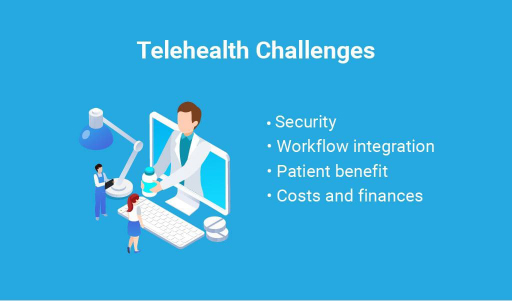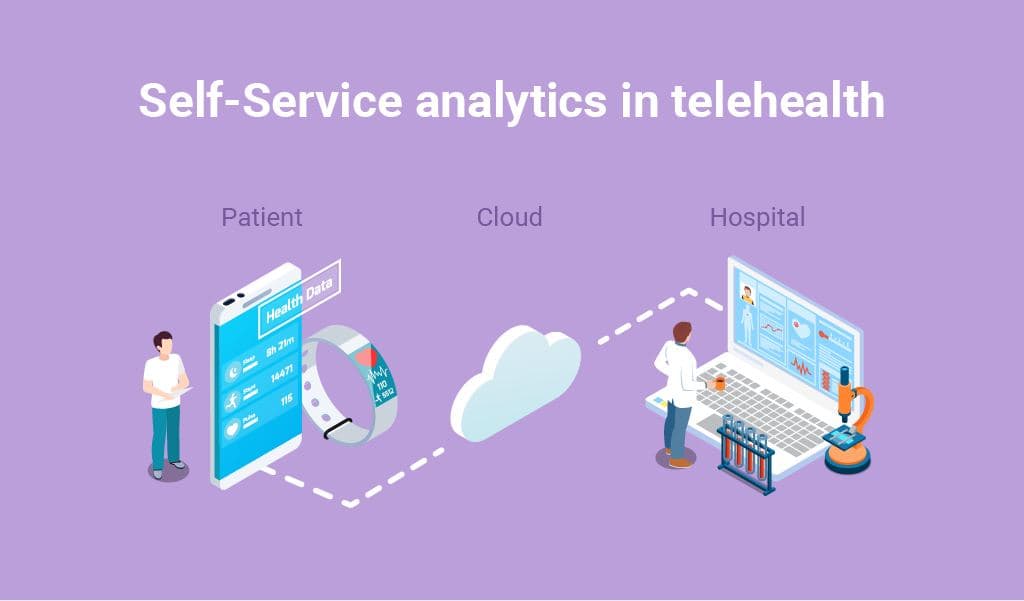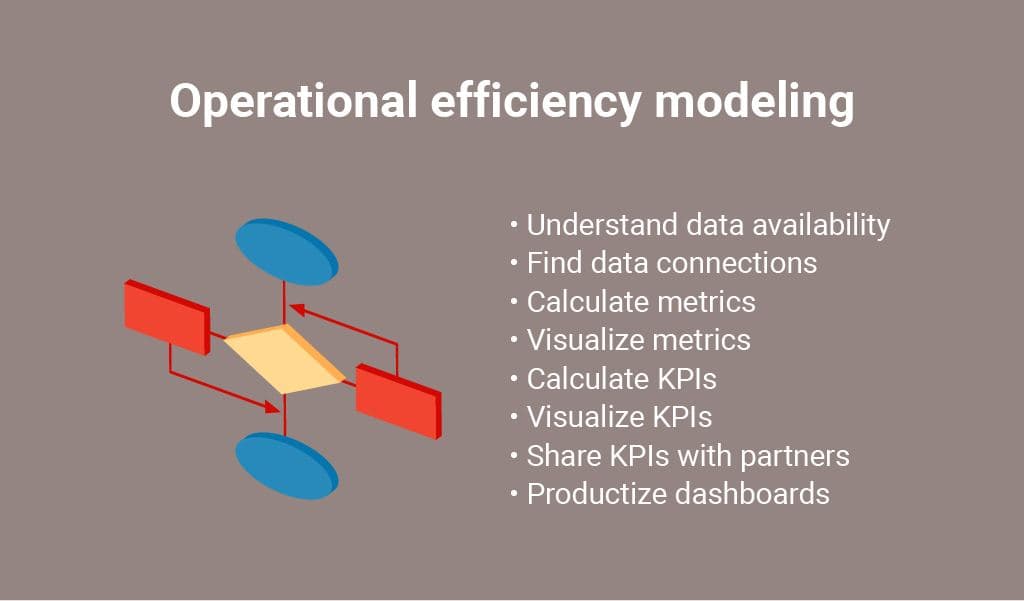Boosting Telehealth Solutions with Self-Service Analytics

Analytic agencies differ in their estimations of telehealth adoption and growth, but all of them confirm that COVID-19 was a major growth catalyst. The reports also show that both patient and provider satisfaction with telehealth is improving, which are a basis for optimistic telehealth growth estimates beyond the pandemic.
Telehealth adoption is growing
According to McKinsey [4] up to “$250 Billion in healthcare spend in 2020 could be shifted to virtual or near-virtual care, or 20 percent of all office, outpatient, and home health spend across Medicare, Medicaid, and commercially insured populations.”

While on-demand virtual urgent care had the highest level of adoption during the pandemic, the business models estimated as having the highest growth potential are virtual office visits (~$165 billion of $250 billion total estimated growth).
Read also: Top 10 Big Data Solutions in Healthcare – Global Forecast to 2025
In order for this estimation to become reality beyond the pandemic, patient and provider satisfaction with telehealth is not enough — a number of obstacles must be confronted first.
Adoption grows despite a set of challenges remaining in telemedicine
Remote health demand during the pandemic led to quick and dirty fixes to existing regulations [7], which made telehealth growth possible and legal. Many businesses were fast to jump on the moving train of expanding opportunities and profit, some without realizing that these relaxed regulations are temporary, and the set of telehealth challenges that existed before the COVID-19 pandemic still remain:

1. Security. COVID-19 caused a burst not only in telehealth but in cybercrime as well. As it frequently happens in the digital world, IT businesses make compromising decisions to support quick growth. Security compliance is weakened to support higher throughput. This is one of the reasons why relaxed regulations had to be introduced in the first place.
Read also: Key Aspects to Consider when Creating Secure Data Platform
2. Workflow integration. This is another example where quick growth support occurs at the expense of smooth patient and provider experiences.
3. Patient benefit. Effectiveness of telehealth solutions compared with in-person visits is a huge challenge. Proper evaluation of telehealth effectiveness requires analysis of diverse data sources, most of which are usually not collected and/or carefully analyzed on a regular basis.
4. Costs and finances. The complexity of reimbursement results in lost revenue, while increasing reimbursement administration costs add up to the effectiveness assessment challenge.
5. Long-term prospects. Following the burst in growth, the telehealth industry has attracted a lot of companies during the last year. However, with the end of the pandemic possibly in sight, telehealth demand (at least temporary) will be lower, which will accelerate the competitiveness on the market [9] and increase the need for specialized solutions.
Precise data-driven analysis of business drivers is a key to success
The post-pandemic reality with stricter regulations and higher market competition requires decision-making agility based on hard facts. The research “Telehealth Finance Variables and Successful Business Models“ [5] refers to the following parts of the centralized telehealth program oversight as pointers towards business success:
- Established and communicated program governance
- Real-time, automated data and reporting dashboards to drive utilization, documentation accuracy, quality, and ROI
- Automated software to facilitate rapid and ongoing tracking of telehealth ROI/VOI
- Maximization of revenue opportunity
Additionally, this research identifies the following variables and KPIs that constitute telehealth ROI:
Variables | KPIs |
| People (clinical providers and patients) | Direct revenue |
| Geography (rural or metropolitan areas) | Avoidable cost |
| Telehealth governance structure | Economies of scale |
| Service provided | Quality |
| Reimbursement or coverage eligibility | Patient satisfaction |
| Technology used | |
| Quality of care rendered | |
| Outcome of the care rendered |
Taking into account the number and complexity of variables and KPIs, it is no wonder that effectiveness assessment is seen as one of the biggest challenges for telehealth. In order to solve it, the telehealth business must get a holistic and precise view of the business. Direct revenue KPI is not enough!
Looking for a solution that works best for your telehealth business?
The experienced engineering team at GreenM can consult with you on how to improve your strategy and get applicable insights.
Self-service analytics to the rescue
What are the solutions? Self-service analytics is often considered one of them. With the rise of self-service analytics tools like Tableau and PowerBI, and increased value derived from data analytics and data science, companies started democratizing in-house business analytics expertise.
Cerainly, this picture looks very optimistic and promising, but the reality is somewhat different. While the adoption of tools and the rise of in-house data analytics is true, its effectiveness and precision vary a lot. The biggest contributor to data analytics effectiveness is data governance program maturity.
Read also: Why Data Governance in Healthcare is Important
The Healthcare business itself is very complex from a data governance standpoint. Telehealth adds another level of complexity, as data generation now happens not only inside the hospital, but on the patient’s side as well. For the cases when telehealth is not a part of the hospital system but a separate business, a data flow is even more complex, since it frequently goes through integrations with multiple EHRs, laboratories, pharmacies, etc.

Self-service analytics focuses on product development and product operational efficiency analyzing data that represents a model of the business operations. Telehealth, more than other types of healthcare services, generates a digital trace of all interactions and provides a huge opportunity for modeling and analysis of what is happening.
For example, from the product development standpoint, it is possible to improve patient outcomes and patient experience by analyzing patient visit history and patient medical records to plan for a more optimal visit schedule: either reduce the number of visits and replace them with asynchronous status checks via messaging technologies or vice versa, temporary increase visit frequency or even suggest in-patient visits for cases that require more provider intervention. As a bonus, such a feature would also improve provider experience working with the system by reducing the schedule management burden.
To make features like this possible, a data science team should explore the general idea, generate a set of hypotheses by exploring the data, and then verify these hypotheses using data analysis. After hypotheses are verified and the data science team identifies key factors and build a model, it can be productized by engineering.
Operational efficiency modeling is about calculating key metrics and combining those to build a set of KPIs. A good example is a telehealth solution that is implemented inside a healthcare system. Such a project is a very complex multi-process that involves stakeholders on different levels. One of the biggest challenges for such implementation is to demonstrate the efficiency of the telehealth implementation by comparing it with in-patient visits. Self-service analytics capability is a proper way to accomplish this task. In-house analytics teams on the telehealth provider side can analyze the data specifically for this healthcare system and provide the dashboards with KPIs demonstrating the efficiency of the implementation.
Read also: Data Analytics in Telemedicine: Usage and Challenges
While cases for the product development and operational efficiency are different, implementation flow is very similar: understand what data is available → find relevant data connections to calculate operational metrics → visualize metrics in a form of dashboards → calculate KPIs based on metrics → visualize KPIs as dashboards → make these dashboards available to the stakeholders → “productize“ these dashboards when necessary by making them a part of the product.

An established self-service analytics program for telehealth allows in-house business experts to analyze variables and build KPIs to enhance data-driven decision-making. But before you get to self-service analytics implementation, make sure to implement mature data governance practices.
Want to stay in the loop? Top 5 handpicked by GreenM healthcare industry insights, cases and business recommendations in your inbox every two weeks. Hit the SUBSCRIBE button below to learn about health tech with our digest or read more news here!
LEARN HOW TO CREATE ADVANCED BUSINESS INTELLIGENCE SYSTEM
How to get system logs from all clients and build comprehensive analytics to track usage, device failure and performance.
References
1. 2020 State of Telemedicine Report https://c8y.doxcdn.com/image/upload/v1/Press Blog/Research Reports/2020-state-telemedicine-report.pdf
3. Fact Sheet: Telehealth | AHA https://www.aha.org/factsheet/telehealth
4. Telehealth: A quarter-trillion-dollar post-COVID-19 reality? https://www.mckinsey.com/industries/healthcare-systems-and-services/our-insights/telehealth-a-quarter-trillion-dollar-post-covid-19-reality
5. Telehealth Finance Variables and Successful Business Models https://telehealthandmedicinetoday.com/index.php/journal/article/view/140/163
6. Priorities for Healthcare and Life Sciences Enforcement in the Biden Administration https://www.sidley.com/en/insights/newsupdates/2021/02/priorities-for-healthcare-and-life-sciences-enforcement-in-the-biden-administration
7. Notification of Enforcement Discretion for Telehealth Remote Communications During the COVID-19 Nationwide Public Health Emergency https://www.hhs.gov/hipaa/for-professionals/special-topics/emergency-preparedness/notification-enforcement-discretion-telehealth/index.html
8. Self-service Analytics https://www.gartner.com/en/information-technology/glossary/self-service-analytics
9. 260+ telehealth companies to know | 2020 https://www.beckershospitalreview.com/lists/260-telehealth-companies-to-know-2020.html






